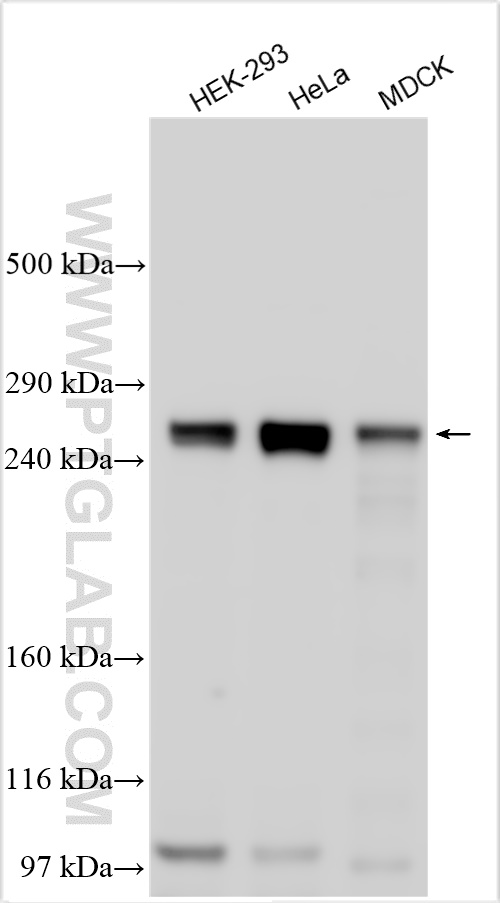验证数据展示
经过测试的应用
| Positive WB detected in | HEK-293 cells, HeLa cells, MDCK cells |
| Positive IP detected in | A549 cells |
推荐稀释比
| 应用 | 推荐稀释比 |
|---|---|
| Western Blot (WB) | WB : 1:500-1:1000 |
| Immunoprecipitation (IP) | IP : 0.5-4.0 ug for 1.0-3.0 mg of total protein lysate |
| It is recommended that this reagent should be titrated in each testing system to obtain optimal results. | |
| Sample-dependent, Check data in validation data gallery. | |
产品信息
25780-1-AP targets MTCL1 in WB, IP, ELISA applications and shows reactivity with human, canine samples.
| 经测试应用 | WB, IP, ELISA Application Description |
| 经测试反应性 | human, canine |
| 免疫原 | MTCL1 fusion protein Ag22718 种属同源性预测 |
| 宿主/亚型 | Rabbit / IgG |
| 抗体类别 | Polyclonal |
| 产品类型 | Antibody |
| 全称 | KIAA0802 |
| 别名 | SOGA2, KIAA0802, CCDC165 |
| 计算分子量 | 1905 aa, 209 kDa |
| 观测分子量 | 250 kDa |
| GenBank蛋白编号 | BC040542 |
| 基因名称 | MTCL1 |
| Gene ID (NCBI) | 23255 |
| RRID | AB_3669499 |
| 偶联类型 | Unconjugated |
| 形式 | Liquid |
| 纯化方式 | Antigen affinity purification |
| UNIPROT ID | Q9Y4B5 |
| 储存缓冲液 | PBS with 0.02% sodium azide and 50% glycerol , pH 7.3 |
| 储存条件 | Store at -20°C. Stable for one year after shipment. Aliquoting is unnecessary for -20oC storage. |
背景介绍
Microtubule cross‐linking factor 1 (MTCL1) is a MT‐regulating protein that plays essential roles in accumulating the non-centrosomal MTs into the apicobasal MT bundles. MTCL1, identified as a binding protein of the cell polarity‐regulating kinase, PAR‐1b/MARK2, is recruited to the Golgi membranes through interactions with CLASPs and AKAP450/CG-NAP, and promotes microtubule growth from the Golgi membrane. Western blot analysis detected MTCL1 at an apparent molecular mass of 250 kDa as indicated in the literature (PMID: 23902687, 28283581).
实验方案
| Product Specific Protocols | |
|---|---|
| WB protocol for MTCL1 antibody 25780-1-AP | Download protocol |
| IP protocol for MTCL1 antibody 25780-1-AP | Download protocol |
| Standard Protocols | |
|---|---|
| Click here to view our Standard Protocols |

